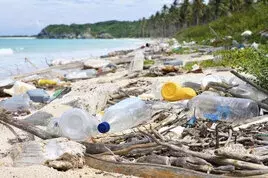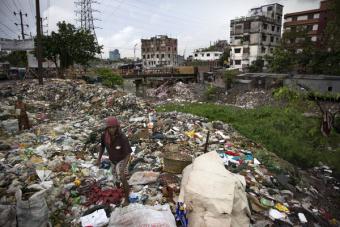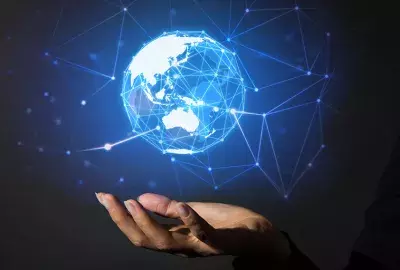Error message

Plastic waste crisis is impacting more people today than climate change, Asia-based advocate says
Quick take:
- With only 10 percent of plastic waste currently being recycled, an estimated two billion people are impacted each day by plastic pollution.
- Almost all types of plastic are now recyclable, but the high cost of collection and machinery is a primary barrier in improving recycling systems.
- If the current rate of plastics production continues, the world would need five to six times more recycling capacity to keep up by 2040.
- A global recycling system is urgently needed, since most smaller countries do not have the capacity to recycle and use their plastic waste.
HONOLULU (Sept. 30, 2021) -- In the decades since the popularity of plastics exploded in the 1960s, nearly 5 billion tons of plastic has littered the planet. On average, eight million tons of plastic waste enter the ocean every year. Yet only 10 percent of plastic is recycled, and the human and environmental costs of plastic pollution continue to grow.
Calling plastic waste “one of the biggest challenges of our time,” Douglas Woodring, founder and managing director of the Ocean Recovery Alliance said in a recent East-West Center Insights webinar that plastic pollution currently impacts more human beings than even climate change. “Two billion people a day are impacted by plastic waste, including bad water, bad agriculture, bad fishing, bad tourism,” he said. “And I would say it's even more complicated actually than climate change.”
Making industry part of the solution

To truly address the problem, Woodring said, the plastics industry needs to be part of the solution. “Plastic is a four-trillion-dollar industry that's not going away. We need to work with it,” he said.
Based in Hong Kong and California, Ocean Recovery Alliance works to reduce seaborne plastic pollution by partnering with governments, businesses, and communities to implement solutions. “Almost all plastic is actually recyclable,” Woodring said from Hong Kong. “This is not a technical issue. This is an infrastructure and a social movement issue.”
Woodring has worked in Asia for nearly three decades helping to launch various global initiatives aimed at reducing and recycling plastic waste. One of them is the Plastic Disclosure Project, which helps manufacturers, businesses and municipalities to better measure and understand their plastic footprint in order to target solutions.
“All plastic trash at some point left someone's hand before it became waste,” Woodring said. Thus it is vital to engage and educate communities at the grassroots level to tackle plastic pollution at its source, where each piece of trash is discarded.

Photo: Paula Bronstein/Getty Images
Cost barriers
High costs are the first major barrier in improving recycling systems, which require collection, sorting, cleaning, and investment in expensive processing equipment. According to Woodring: “The challenge is really finding who is able to finance these thousands of pieces of equipment that need to go out to all the communities to recover this material.”
Corporate pledges to increase use of recycled plastics have multiplied of late. Nestlé, for example, has committed $2.1 billion by 2025 to buy recycled content for its products. But such pledges ignore the shortage in necessary recycling infrastructure, Woodring said. Meanwhile, the market for recycled plastic is expected to grow 30 percent by 2025, creating a further “demand gap” that can’t be met by global processing capacity.
Global recycling system is ‘the only way’
If the current rate of plastics production continues, by 2040 the world would need five to six times its current mechanical recycling capacity to keep up. According to Woodring, critical infrastructure must be developed to handle plastic not only in large city hubs, but also in smaller municipalities where plastics need to be collected, processed, and transferred to larger recycling factories. “Recycling is starting to boom,” he said. “The problem is that the infrastructure and the supply chains to make it happen are not there yet.”

Photo: Allison Joyce/Getty Images
Since China cut back on its imports of waste and recyclables in 2018, there are few places left to ship plastic for processing and recycling overseas. As a result, plastic waste is now backing up on the doorsteps of countries that do not have their own recycling machinery. “The only way to really make circularity work for plastic is to have a global system, because most of the small countries cannot process it and absorb it in their manufacturing,” Woodring said. “That's the big dilemma and challenge that the world is facing right now.”
Without urgent global investment in waste recovery and recycling, he said, there will soon be “many, many more times plastic in the environment than there is today.”
Top Photo: Apomares/Getty Images
Plastic waste crisis is impacting more people today than climate change, Asia-based advocate says
Quick take:
- With only 10 percent of plastic waste currently being recycled, an estimated two billion people are impacted each day by plastic pollution.
- Almost all types of plastic are now recyclable, but the high cost of collection and machinery is a primary barrier in improving recycling systems.
- If the current rate of plastics production continues, the world would need five to six times more recycling capacity to keep up by 2040.
- A global recycling system is urgently needed, since most smaller countries do not have the capacity to recycle and use their plastic waste.
HONOLULU (Sept. 30, 2021) -- In the decades since the popularity of plastics exploded in the 1960s, nearly 5 billion tons of plastic has littered the planet. On average, eight million tons of plastic waste enter the ocean every year. Yet only 10 percent of plastic is recycled, and the human and environmental costs of plastic pollution continue to grow.
Calling plastic waste “one of the biggest challenges of our time,” Douglas Woodring, founder and managing director of the Ocean Recovery Alliance said in a recent East-West Center Insights webinar that plastic pollution currently impacts more human beings than even climate change. “Two billion people a day are impacted by plastic waste, including bad water, bad agriculture, bad fishing, bad tourism,” he said. “And I would say it's even more complicated actually than climate change.”
Making industry part of the solution

To truly address the problem, Woodring said, the plastics industry needs to be part of the solution. “Plastic is a four-trillion-dollar industry that's not going away. We need to work with it,” he said.
Based in Hong Kong and California, Ocean Recovery Alliance works to reduce seaborne plastic pollution by partnering with governments, businesses, and communities to implement solutions. “Almost all plastic is actually recyclable,” Woodring said from Hong Kong. “This is not a technical issue. This is an infrastructure and a social movement issue.”
Woodring has worked in Asia for nearly three decades helping to launch various global initiatives aimed at reducing and recycling plastic waste. One of them is the Plastic Disclosure Project, which helps manufacturers, businesses and municipalities to better measure and understand their plastic footprint in order to target solutions.
“All plastic trash at some point left someone's hand before it became waste,” Woodring said. Thus it is vital to engage and educate communities at the grassroots level to tackle plastic pollution at its source, where each piece of trash is discarded.

Photo: Paula Bronstein/Getty Images
Cost barriers
High costs are the first major barrier in improving recycling systems, which require collection, sorting, cleaning, and investment in expensive processing equipment. According to Woodring: “The challenge is really finding who is able to finance these thousands of pieces of equipment that need to go out to all the communities to recover this material.”
Corporate pledges to increase use of recycled plastics have multiplied of late. Nestlé, for example, has committed $2.1 billion by 2025 to buy recycled content for its products. But such pledges ignore the shortage in necessary recycling infrastructure, Woodring said. Meanwhile, the market for recycled plastic is expected to grow 30 percent by 2025, creating a further “demand gap” that can’t be met by global processing capacity.
Global recycling system is ‘the only way’
If the current rate of plastics production continues, by 2040 the world would need five to six times its current mechanical recycling capacity to keep up. According to Woodring, critical infrastructure must be developed to handle plastic not only in large city hubs, but also in smaller municipalities where plastics need to be collected, processed, and transferred to larger recycling factories. “Recycling is starting to boom,” he said. “The problem is that the infrastructure and the supply chains to make it happen are not there yet.”

Photo: Allison Joyce/Getty Images
Since China cut back on its imports of waste and recyclables in 2018, there are few places left to ship plastic for processing and recycling overseas. As a result, plastic waste is now backing up on the doorsteps of countries that do not have their own recycling machinery. “The only way to really make circularity work for plastic is to have a global system, because most of the small countries cannot process it and absorb it in their manufacturing,” Woodring said. “That's the big dilemma and challenge that the world is facing right now.”
Without urgent global investment in waste recovery and recycling, he said, there will soon be “many, many more times plastic in the environment than there is today.”
Top Photo: Apomares/Getty Images
East-West Wire
News, Commentary, and Analysis
The East-West Wire is a news, commentary, and analysis service provided by the East-West Center in Honolulu. Any part or all of the Wire content may be used by media with attribution to the East-West Center or the person quoted. To receive East-West Center Wire media releases via email, subscribe here.
For links to all East-West Center media programs, fellowships and services, see www.eastwestcenter.org/journalists.







